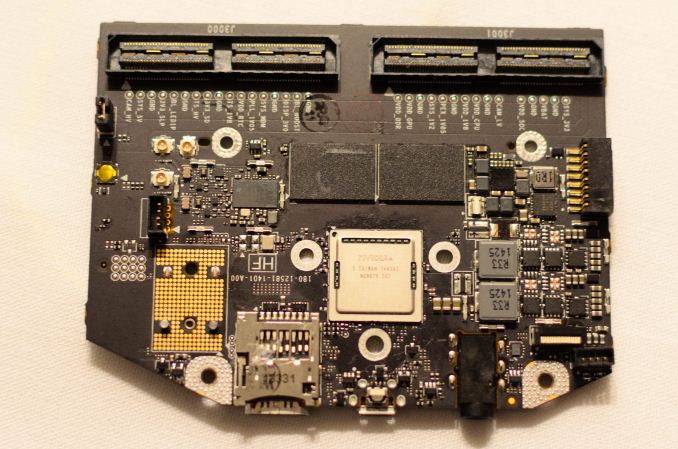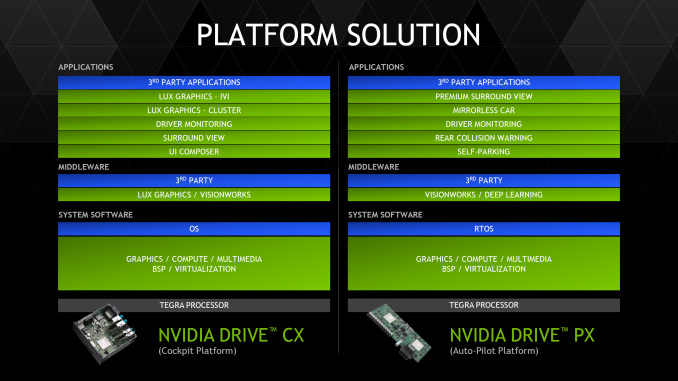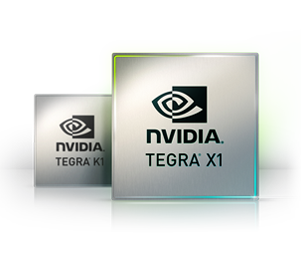NVIDIA Tegra X1 Preview & Architecture Analysis
by Joshua Ho & Ryan Smith on January 5, 2015 1:00 AM EST- Posted in
- SoCs
- Arm
- Project Denver
- Mobile
- 20nm
- GPUs
- Tablets
- NVIDIA
- Cortex A57
- Tegra X1
Final Words
With the Tegra X1, there have been a great deal of changes when compared to Tegra K1. We see a move from Cortex A15 to A57 on the main cluster, and a move from a single low power Cortex A15 to four Cortex A53s which is a significant departure from previous Tegra SoCs. However, the CPU design remains distinct from what we see in SoCs like the Exynos 5433, as NVIDIA uses a custom CPU interconnect and cluster migration instead of ARM’s CCI-400 and global task scheduling. Outside of these CPU changes, NVIDIA has done a great deal of work on the uncore, with a much faster ISP and support for new codecs at high resolution and frame rate, along with an improved memory interface and improved display output.
Outside of CPU, the GPU is a massive improvement with the move to Maxwell. The addition of double-speed FP16 support for the Tegra X1 helps to improve performance and power efficiency in applications that will utilize FP16, and in general the mobile-first focus on the architecture makes for a 2x improvement in performance per watt. While Tegra K1 set a new bar for mobile graphics for other SoC designers to target, Tegra X1 manages to raise the bar again in a big way. Given the standards support of Tegra X1, it wouldn’t be a far leap to see more extensive porting of games to a version of SHIELD Tablet with Tegra X1.
NVIDIA has also made automotive applications a huge focus in Tegra X1 in the form of DRIVE CX, a cockpit computing platform, and DRIVE PX, an autopilot platform. Given the level of integration and compute present in both DRIVE CX and PX, there seems to be a significant amount of value in NVIDIA’s solutions. However, it remains to be seen whether OEMs will widely adopt these solutions as car manufacturers can take multiple years to implement a new SoC. Compared to the 3-4 month adoption rate of an SoC in a phone or tablet, it's hard to pass any judgment on whether or not NVIDIA's automotive endeavors will be a success.
Overall, Tegra X1 represents a solid improvement over Tegra K1, and now that NVIDIA has shifted their GPU architectures to be targeted at mobile first, we’re seeing the benefits that come with such a strategy. It seems obvious that this would be a great SoC to put in a gaming tablet and a variety of other mobile devices, but it remains to be seen whether NVIDIA can get the design wins necessary to make this happen. Given that all of the high-end SoCs in the Android space will be shipping with A57 and A53 CPUs, the high-end SoC space will see significant competition once again.













194 Comments
View All Comments
SM123456 - Sunday, February 1, 2015 - link
>>He was saying: why NV didn't continue with Denver design? Being so efficient and only 2 cores why don't shift at 20nn easily? Because they can't and that's it. The other things are speculations.<<There is a simple answer to that - Apple has booked all the production slots for 20nm (made by foundry TSMC) to meet demand for the A8. This has pushed back production of the 16nm to late 2015. That is the reason for the delay in Denver, which nVidia originally intended for the Tegra K1 Denver successor, the Pascal chip. That is the reason for the delay in Pascal.
20nm is a risk reducing interim technology which almost everybody is skipping. Apple originally wanted 14/16nm for the A8, only used 20nm because they couldn't wait to release the current iPhone on 14/16nm. nVidia is only producing the Tegra X1 at 20nm because they are worried about the same problem happening at 16nm. With 20nm, they know that Apple will be moving off 20nm with the next iPhone, so there will definitely be spare production capacity.
utferris - Monday, April 13, 2015 - link
I can not agree you any more. They aliens can not be reasonable.GC2:CS - Wednesday, January 7, 2015 - link
2) I could make 4 cluster A7 GPU faster than tegra K1 and I could make a 16 cluster series 7XT GPU that's slower than tegra K1.So tell me how the heck does the number of clusters or "cores" relates to efficiency ???
lucam - Wednesday, January 7, 2015 - link
Since you re so expert about Imagt cluster you can explain why there some model of G6230 - 2 clusters (Allwinner socs) fast as much as an A7 (G6430) - 4 clusters. Maybe because the former has clock frequency higher than latter? But are pretty much the same in term of performance/watt....there we go..SM123456 - Sunday, February 1, 2015 - link
Errr.. same performance and price per watt for Apple on 20nm as nVidia at 28nm? That is damning.SM123456 - Sunday, February 1, 2015 - link
The cores aren't important, the performance is. That is the whole point. The responsiveness depends on single core performance and to a lesser extent two core performance, and on this point Denver beats the crap out of the Apple A8 and A8X. Therefore the fact that Apple added an extra core to the A8 to get A8X is about benchmark bragging rights, and the A8X real world performance (based on single and dual core performance) lags the Tegra K1 Denver even with A8X on 20nm and Denver K1 on 28nm - not good for Apple.lucam - Tuesday, January 6, 2015 - link
The Tegra speculations of chizow are priceless!aenews - Saturday, January 24, 2015 - link
The K1 is four months or so older than the A8X. It crushed every chip very badly for four whole months. If anything, everyone else was/is playing catchup. And not to mention the Snapdragon 810, yet to be released, does not even come close to the K1 despite being a year newer.utferris - Monday, April 13, 2015 - link
> "The K1 is four months or so older than the A8X."How do you come up with that?
A8X was in production way before K1.
It is just you see A8X only on ipad, when NVidia is showing off all around the test board that does not actually in production.
chizow - Monday, January 5, 2015 - link
@Mayuyu; I wouldn't be surprised if this is the final outcome of the Nvidia IP Patent lawsuits and why Apple was excluded from the original litigation. My bet is they (Apple) have already engaged in serious talks with Nvidia and they are both just awaiting a favorable outcome against Samsung/Qualcomm before moving forward.